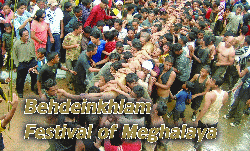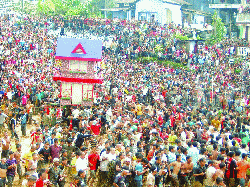Behdienkhlam Festival of Meghalaya
Behdienkhlam Festival of Meghalaya
 Forming one of the main regions of the beautiful state of Meghalaya, one of India’s most popular tourist attractions, the Jaintia Hills are famous for the way they have held on to their tribal culture even today, in an age of modernism. One of the most important features
Forming one of the main regions of the beautiful state of Meghalaya, one of India’s most popular tourist attractions, the Jaintia Hills are famous for the way they have held on to their tribal culture even today, in an age of modernism. One of the most important features
of the tribal charm of Meghalaya is the Behdienkhlam Festival, (June-July) which remains as one of the most popular festivals of the region.
The Behdienkhlam Festival, is celebrated by the Pnars as a form of homage which is paid to the Gods of the Seven Huts who arrived in the region from heaven and established a kingdom here. A prediction claimed that the region would suffer a violent plague that threatened to wipe out the entire tribe. Scared by this ill-fortuned prediction, the Jowai people traveled to the shrine of their protector deities Mulong, Mooralong U Mukhai and Musniang who advised them to worship the divine elements in the form of the festival of Behdienkhlam which was to be held annually. Thus, the festival is also known as the festival for chasing away the Demon of Cholera. Today, however the festival has another important significance. It is used as a prayer seeking divine blessings for a rich harvest in the year ahead
Rituals of the Behdienkhlam FestivalThe festival of Behdienkhlam begins with a ritual in which the Daloi or the chief of the tribe opens the proceedings with a ceremonial invocation to the Gods of the tribes through a series of religious rites. Following this is one of the most popular rituals of the festival where young men symbolize the flight of the evil spirit by beating the roof of every house in the village with bamboo poles. However, the main attraction of the f estival takes place when young men fight for the possession of a huge beam, a fightwhich is characterized by smearing of mud on all the participants.
estival takes place when young men fight for the possession of a huge beam, a fightwhich is characterized by smearing of mud on all the participants.
Concluding Ceremony
The festival of Behdienkhlam reaches its conclusion with the Dad-lawakor ceremony in which groups of men jostle for the possession of a wooden ball, a game which is remotely similar to football. The festival ends with a final salutation to the divine powers when the women of the tribe offer sacrificial food to the Almighty.


